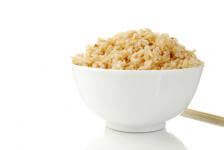How Much Rice is Safe to Eat?
The FDA and the Consumer’s Union released independent test results showing that some brown rice products in the U.S. contained high levels of arsenic. Should you be concerned? Nutrition Diva explains.
Monica Reinagel, MS, LD/N, CNS

by Monica Reinagel, M.S., L.D./N.
Q. In response to a recent findings on arsenic in rice, the FDA told the Washington Post that they are “not prepared, based on preliminary data, to advise people to change their eating patterns.” What advice do you have?
Answer. Since my last podcast on this topic, both the FDA and the Consumer’s Union released independent test results showing that some (but not all) brown rice products for sale in the U.S. contained alarmingly high levels of arsenic. Yet the FDA says they don’t have enough evidence to advise consumers to make any changes in their eating habits.
Of all people, I can appreciate the hesitation to jump to conclusions or ignite a false firestorm of
You don’t have to completely eliminate brown rice from your diet. But until we know more, I think it would be prudent to limit your consumption of brown rice and brown rice products to 2-3 servings a week. If you’re eating it twice a day, mix it up a bit. Have some quinoa!

